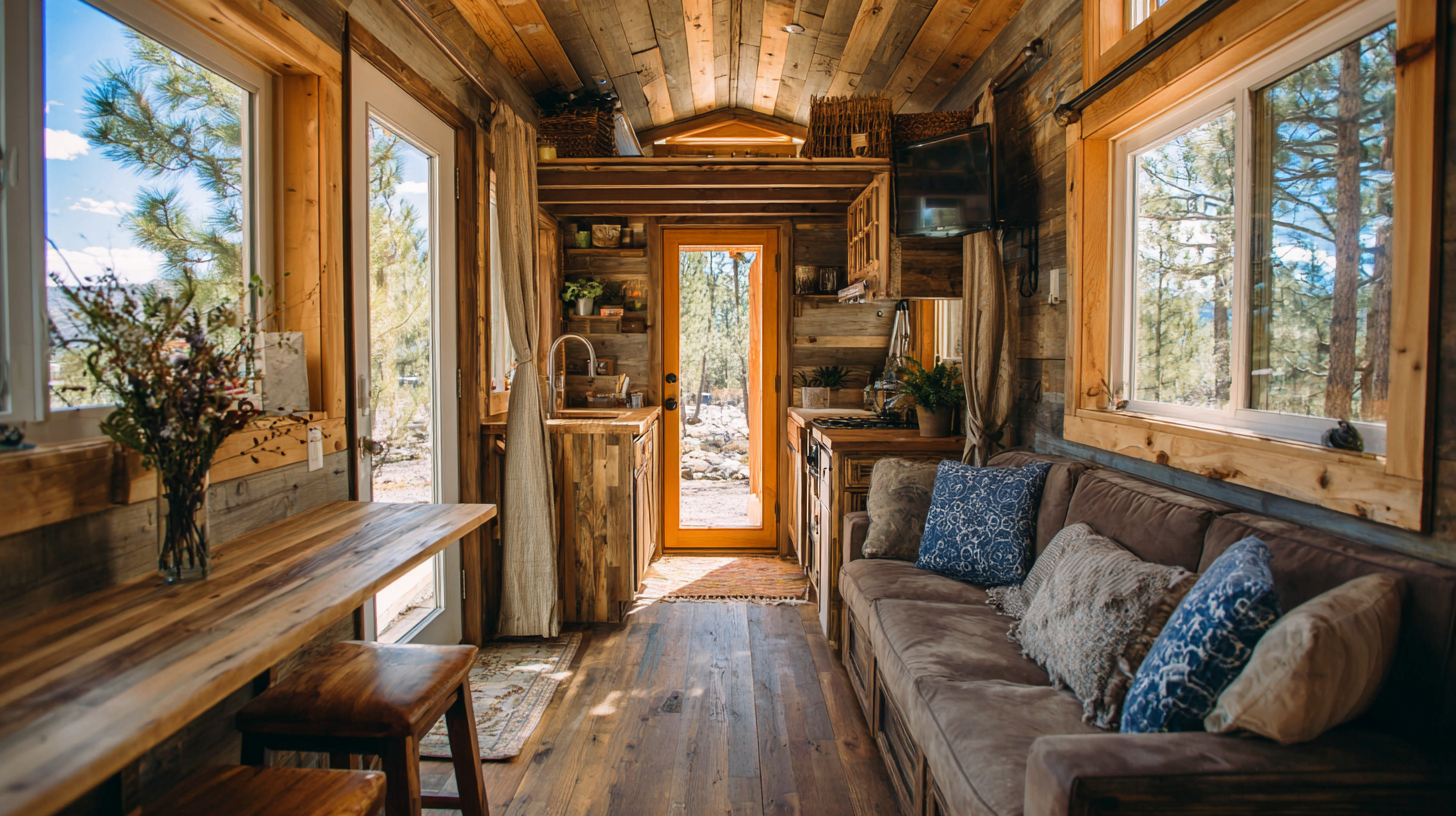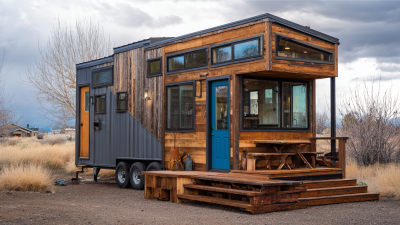Exploring the Tiny House Movement: How Minimalism is Shaping Sustainable Living Today
 The tiny house movement represents a radical shift in how individuals and communities perceive lifestyle choices and sustainability. This paradigm embraces minimalism, challenging the conventional notions of home ownership and consumerism. As housing prices soar and environmental concerns mount, the tiny house movement offers an innovative solution that emphasizes efficiency, simplicity, and a profound connection to the environment. Potential homeowners are drawn not only to the allure of smaller, more affordable living spaces but also to the idea of reducing their ecological footprint. This movement fosters a culture of conscious living, where each choice has a significant impact on both personal well-being and the planet. By examining the principles and practices of the tiny house movement, we can gain insights into how minimalism is reshaping sustainable living today, offering a blueprint for a more responsible and fulfilling way of life.
The tiny house movement represents a radical shift in how individuals and communities perceive lifestyle choices and sustainability. This paradigm embraces minimalism, challenging the conventional notions of home ownership and consumerism. As housing prices soar and environmental concerns mount, the tiny house movement offers an innovative solution that emphasizes efficiency, simplicity, and a profound connection to the environment. Potential homeowners are drawn not only to the allure of smaller, more affordable living spaces but also to the idea of reducing their ecological footprint. This movement fosters a culture of conscious living, where each choice has a significant impact on both personal well-being and the planet. By examining the principles and practices of the tiny house movement, we can gain insights into how minimalism is reshaping sustainable living today, offering a blueprint for a more responsible and fulfilling way of life.
Understanding the Philosophy Behind the Tiny House Movement: A Journey into Minimalism
The tiny house movement is more than just a trend; it's a comprehensive lifestyle choice that embodies the principles of minimalism at its core. At its foundation, minimalism encourages individuals to reassess their values and possessions, stripping away the clutter that distracts from what truly matters. For many, living in a tiny house means embracing a simpler life, focusing on experiences over material goods. This philosophy aligns perfectly with the ideals of sustainability, as smaller living spaces often lead to reduced waste and lower energy consumption.
By choosing to downsize, individuals often find greater freedom and flexibility in their lives. With fewer possessions to manage, the focus shifts to quality over quantity. The minimalist approach fosters a deeper connection with the environment and the community, encouraging practices that are not only beneficial for the individual but also for the planet. As people embark on this journey into minimalism, they discover the profound impact that living simply can have on their overall well-being and happiness, turning the tiny house movement into a canvas for personal growth and sustainability.
Exploring the Tiny House Movement: How Minimalism is Shaping Sustainable Living Today
| Dimension | Description | Impact on Sustainability |
|---|---|---|
| Living Space | Average size ranges from 100 to 400 square feet. | Reduces resource consumption and energy usage. |
| Cost | Typically ranges from $10,000 to $100,000. | Lower financial burden allows for sustainable choices. |
| Mobility | Many tiny houses are mobile, built on trailers. | Encourages living closer to nature and reduces urban sprawl. |
| Environmental Impact | Reduced carbon footprint through smaller living spaces. | Promotes eco-friendly materials and practices. |
| Community | Encourages a sense of community and shared resources. | Fosters collective sustainability efforts. |
Key Design Principles of Tiny Houses: Maximizing Space and Functionality
 The Tiny House Movement emphasizes the importance of maximizing space and functionality, making it a paramount consideration in the design of these compact living spaces. One of the key principles is the integration of multifunctional furniture, which allows for a seamless transition between different activities. For instance, a sofa may transform into a bed and then into a dining space, effectively saving valuable square footage. This approach not only enhances utility but also promotes a minimalist lifestyle, where each item serves a purpose.
The Tiny House Movement emphasizes the importance of maximizing space and functionality, making it a paramount consideration in the design of these compact living spaces. One of the key principles is the integration of multifunctional furniture, which allows for a seamless transition between different activities. For instance, a sofa may transform into a bed and then into a dining space, effectively saving valuable square footage. This approach not only enhances utility but also promotes a minimalist lifestyle, where each item serves a purpose.
Another crucial aspect is the clever use of vertical space, which is often overlooked in traditional home designs. Tiny houses frequently feature lofted sleeping areas and built-in shelving that extend upward, drawing the eye and creating an illusion of height. Additionally, many designs incorporate large windows to flood the interior with natural light, making the space feel more open and inviting. These design principles collectively foster a sense of coziness while also supporting the tenants’ desire for sustainability and reduced clutter, ultimately redefining the notion of home in a world increasingly leaning towards minimalism.
Sustainable Living Practices: How Tiny House Dwellers Contribute to Environmental Stewardship
The tiny house movement embodies the principles of minimalism and sustainability, inviting dwellers to rethink their relationship with space and consumption. By living in smaller homes, individuals can significantly reduce their ecological footprint. Tiny house dwellers often prioritize energy-efficient appliances, renewable energy sources, and sustainable materials, showcasing a commitment to environmental stewardship. This lifestyle not only promotes a simpler way of living but also fosters a sense of community as like-minded individuals share resources and ideas.
**Tip:** When considering a move to a tiny house, start by decluttering your belongings. Evaluate what you truly need and donate or recycle items that no longer serve a purpose in your life.
Sustainable living practices thrive in tiny home communities. Residents often engage in collective gardening, composting, and water conservation measures, which strengthen their connection to nature and promote a healthier environment. Through these actions, tiny house dwellers become stewards of the earth, demonstrating that sustainable choices can lead to a fulfilling lifestyle.
**Tip:** Look into local resources or workshops focused on sustainable practices. Many communities offer classes on topics like permaculture, which can enhance your skills in eco-friendly gardening and other sustainable living practices.
Exploring the Tiny House Movement: Minimalism and Sustainable Living
Overcoming Challenges: Navigating Zoning Laws and Financing for Tiny Homes
 Navigating the tiny house movement can be a rewarding yet challenging journey, particularly when it comes to zoning laws and financing. Many municipalities have strict regulations that govern where tiny homes can be placed. These laws often stem from traditional zoning frameworks that prioritize larger, single-family residences. To successfully overcome these challenges, potential tiny home owners must conduct thorough research to understand local regulations.
Joining online communities or consulting with tiny house advocates can provide valuable insights and strategies for negotiating zoning restrictions, which may include applying for variances or seeking alternative sites, such as mobile home parks that accommodate small dwellings.
Navigating the tiny house movement can be a rewarding yet challenging journey, particularly when it comes to zoning laws and financing. Many municipalities have strict regulations that govern where tiny homes can be placed. These laws often stem from traditional zoning frameworks that prioritize larger, single-family residences. To successfully overcome these challenges, potential tiny home owners must conduct thorough research to understand local regulations.
Joining online communities or consulting with tiny house advocates can provide valuable insights and strategies for negotiating zoning restrictions, which may include applying for variances or seeking alternative sites, such as mobile home parks that accommodate small dwellings.
Financing tiny homes presents its own set of difficulties. Traditional mortgage lenders often view these homes as non-conventional properties, which may lead to hurdles in obtaining a loan. As a result, aspiring tiny home dwellers may need to explore alternative financing options, such as personal loans, crowdfunding, or seller financing. Additionally, the rising popularity of tiny homes has led some lenders to develop specific products tailored to this market, expanding the choices available for financing. By being proactive and resourceful, individuals can not only navigate the complexities of zoning laws but also secure appropriate funding to bring their tiny living visions to fruition.
Building a Tiny Community: The Social Impact of Minimalist Living on Relationships and Community Structures
The tiny house movement is not just a trend; it's a profound shift in how we perceive community and relationships in the context of minimalist living. As people downsize their homes, they often find themselves re-evaluating their social interactions and prioritizing meaningful connections. According to a report by the American Institute of Architects, 68% of tiny house dwellers reported feeling more connected to their neighbors than when living in larger homes. This remarkable statistic underscores the growing sense of community that emerges from shared spaces and common values.
Building a tiny community can significantly enhance social bonds. With fewer possessions, individuals tend to foster a culture of sharing and collaboration. For instance, many tiny house communities incorporate communal areas and shared resources, which not only promote efficiency but also invite social interaction. Participating in community events and support networks can lead to stronger interpersonal ties and an increased sense of belonging.
Tips for Fostering Community in Tiny Living:
1. Engage in Local Events: Participate in gatherings, workshops, and local markets to meet others in your community and cultivate relationships.
2. Create Shared Spaces: Design communal areas like gardens or meeting rooms where residents can come together and connect regularly.
3. Promote Open Communication: Encourage transparency and dialogue among neighbors to build trust and foster a supportive environment.
These simple strategies can profoundly impact how individuals living in tiny homes connect with one another, creating a vibrant and resilient community.


